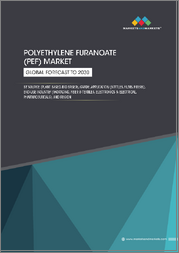
|
시장보고서
상품코드
1687635
PEF(Polyethylene Furanoate) 시장 규모, 점유율, 성장 분석 : 공급원별, 등급별, 용도별, 최종 용도 산업별, 지역별 - 산업 예측(2025-2032년)Polyethylene Furanoate Market Size, Share, and Growth Analysis, By Source (Plant Based, Bio Based), By Grade (Standard Grade, High-Performance Grade), By Application, By End-Use Industry, By Region - Industry Forecast 2025-2032 |
||||||
세계의 PEF(Polyethylene Furanoate) 시장 규모는 2023년에 372억 달러로 평가되며, 예측 기간 중(2025-2032년) CAGR 7.6%로 성장하며, 2024년 400억 3,000만 달러에서 2032년에는 719억 2,000만 달러로 성장할 전망입니다.
폴리에틸렌 푸라노에이트(PEF) 시장은 지속가능한 포장 솔루션에 대한 수요 증가, 재료 특성의 향상, 생산 공정의 기술 발전으로 인해 크게 성장할 것으로 예상됩니다. 기후 변화에 대한 우려가 커짐에 따라 기업은 생분해성과 낮은 탄소발자국을 이유로 바이오 PEF를 채택하는 경향이 증가하고 있으며, PEF의 우수한 장벽 특성은 포장 분야에서 PEF의 매력을 더욱 높여주고 있습니다. 촉매 공정과 중합 기술의 혁신으로 수율과 제품 품질이 향상되어 제조업체들이 사업을 확장할 수 있게 되었으며, PEF 생산 기술을 강화하기 위한 Avantium의 파트너십과 같은 공동 구상은 새로운 시장 기회를 창출하고 있습니다. 그러나 높은 생산 비용과 다른 소재와의 경쟁 등의 문제가 수요를 저해할 가능성도 있습니다. 전반적으로 지속가능성으로의 전환은 향후 수년간 PEF 시장의 성장 궤도에 유리하게 작용할 것으로 예상됩니다.
목차
서론
- 조사의 목적
- 조사 범위
- 정의
조사 방법
- 정보 조달
- 2차와 1차 데이터 방법
- 시장 규모 예측
- 시장의 전제조건과 제한
개요
- 세계 시장 전망
- 공급과 수요 동향 분석
- 부문별 기회 분석
시장 역학과 전망
- 시장 개요
- 시장 규모
- 시장 역학
- 촉진요인과 기회
- 억제요인과 과제
- Porter의 산업 분석
주요 시장 인사이트
- 주요 성공 요인
- 경쟁의 정도
- 주요 투자 기회
- 시장 에코시스템
- 시장의 매력 지수(2024년)
- PESTEL 분석
- 거시경제 지표
- 밸류체인 분석
- 가격 분석
- 사례 연구 분석
- 고객과 구매 기준 분석
PEF(Polyethylene Furanoate) 시장 규모 : 공급원별 & CAGR(2025-2032)
- 시장 개요
- 식물 기반
- 바이오 기반
PEF(Polyethylene Furanoate) 시장 규모 : 등급별 & CAGR(2025-2032)
- 시장 개요
- 표준 등급
- 고성능 등급
- 블렌드/커스터마이즈 등급
- 기타 등급
PEF(Polyethylene Furanoate) 시장 규모 : 용도별 & CAGR(2025-2032)
- 시장 개요
- 보틀
- 섬유
- 필름
- 성형 부품
- 압출 부품
- 기타 용도
PEF(Polyethylene Furanoate) 시장 규모 : 최종 용도 산업별 & CAGR(2025-2032)
- 시장 개요
- 포장
- 섬유·직물
- 전자·전기 부품
- 자동차 부품
- 의약품
- 기타 최종 용도 산업
PEF(Polyethylene Furanoate) 시장 규모 : 지역별 & CAGR(2025-2032)
- 북미
- 미국
- 캐나다
- 유럽
- 독일
- 스페인
- 프랑스
- 영국
- 이탈리아
- 기타 유럽 지역
- 아시아태평양
- 중국
- 인도
- 일본
- 한국
- 기타 아시아태평양
- 라틴아메리카
- 브라질
- 기타 라틴아메리카 지역
- 중동 및 아프리카
- GCC 국가
- 남아프리카공화국
- 기타 중동 및 아프리카
경쟁 정보
- 상위 5사의 비교
- 주요 기업의 시장 포지셔닝(2024년)
- 주요 시장 기업이 채택한 전략
- 최근 시장 동향
- 기업의 시장 점유율 분석(2024년)
- 주요 기업의 기업 개요
- 기업의 상세
- 제품 포트폴리오 분석
- 기업의 부문별 점유율 분석
- 매출의 전년대비 비교(2022-2024)
주요 기업 개요
- Avantium N.V.(Netherlands)
- BASF(Germany)
- Swicofil AG(Switzerland)
- TOYOBO CO. LTD.(Japan)
- Danone(France)
- ALPLA(Austria)
- Gevo Inc.(United States)
- ADM(Archer Daniels Midland)(United States)
- Corbion(Netherlands)
- Mitsui Chemicals Inc.(Japan)
- DuPont(United States)
- Origin Materials(United States)
결론과 제안
KSA 25.04.24Global Polyethylene Furanoate Market size was valued at USD 37.2 billion in 2023 and is poised to grow from USD 40.03 billion in 2024 to USD 71.92 billion by 2032, growing at a CAGR of 7.6% during the forecast period (2025-2032).
The polyethylene furanoate (PEF) market is poised for significant growth driven by rising demand for sustainable packaging solutions, enhanced material properties, and technological advancements in production processes. As concerns over climate change escalate, companies are increasingly adopting bio-based PEF for its biodegradability and low carbon footprint. PEF's exceptional barrier properties further bolster its appeal in the packaging sector. Innovations in catalytic processes and polymerization techniques are improving yield and product quality, enabling manufacturers to scale operations. Collaborative initiatives, such as Avantium's partnerships to enhance PEF production technologies, are creating new market opportunities. However, challenges including high production costs and competition from other materials may hinder demand. Overall, the shift toward sustainability is expected to favor the PEF market's growth trajectory in the coming years.
Top-down and bottom-up approaches were used to estimate and validate the size of the Global Polyethylene Furanoate market and to estimate the size of various other dependent submarkets. The research methodology used to estimate the market size includes the following details: The key players in the market were identified through secondary research, and their market shares in the respective regions were determined through primary and secondary research. This entire procedure includes the study of the annual and financial reports of the top market players and extensive interviews for key insights from industry leaders such as CEOs, VPs, directors, and marketing executives. All percentage shares split, and breakdowns were determined using secondary sources and verified through Primary sources. All possible parameters that affect the markets covered in this research study have been accounted for, viewed in extensive detail, verified through primary research, and analyzed to get the final quantitative and qualitative data.
Global Polyethylene Furanoate Market Segments Analysis
Global Polyethylene Furanoate Market is segmented by Source, Grade, Application, End-Use Industry and region. Based on Source, the market is segmented into Plant Based and Bio Based. Based on Grade, the market is segmented into Standard Grade, High-Performance Grade, Blended/Customized Grade and Other Grades. Based on Application, the market is segmented into Bottles, Fibers, Films, Molded Components, Extruded Components and Other Applications. Based on End-Use Industry, the market is segmented into Packaging, Fiber & Textile, Electronic & Electrical Components, Automotive Components, Pharmaceuticals and Other End-Use Industries. Based on region, the market is segmented into North America, Europe, Asia Pacific, Latin America and Middle East & Africa.
Driver of the Global Polyethylene Furanoate Market
The Global Polyethylene Furanoate market is anticipated to experience significant growth driven by the increasing focus on sustainability and the concerted efforts to minimize packaging waste worldwide. As a bio-based polymer sourced from renewable materials, polyethylene furanoate presents an eco-friendly alternative to conventional plastics such as PET. This shift towards more sustainable packaging solutions not only aligns with environmental goals but also supports the expansion of the global polyethylene furanoate market. Consequently, the rising demand for sustainable products is expected to significantly influence the market dynamics in the years ahead.
Restraints in the Global Polyethylene Furanoate Market
The Global Polyethylene Furanoate market faces significant challenges largely due to the high production costs associated with this material, which are currently much greater than those of traditional plastics such as PET. Factors contributing to these elevated costs include the use of specialized equipment and raw materials as well as the implementation of unique manufacturing processes tailored for polyethylene furanoate. These financial burdens hinder the material's broader adoption across various industry sectors, consequently restricting its market penetration and limiting the potential for revenue generation. Addressing these cost issues will be crucial for the future growth of the polyethylene furanoate market.
Market Trends of the Global Polyethylene Furanoate Market
The Global Polyethylene Furanoate market is poised for significant growth as manufacturers ramp up production capacity to meet increasing demand. This trend is driven by a growing awareness of sustainability and the shift towards renewable materials in packaging and textile applications. Current limitations in production have hindered market expansion; thus, companies that strategically invest in scaling their operations stand to gain a competitive advantage. By harnessing advanced technologies and optimizing resource utilization, the sector can overcome capacity constraints, tapping into lucrative opportunities and driving the widespread adoption of polyethylene furanoate as a viable alternative to traditional plastics in a more eco-conscious marketplace.
Table of Contents
Introduction
- Objectives of the Study
- Scope of the Report
- Definitions
Research Methodology
- Information Procurement
- Secondary & Primary Data Methods
- Market Size Estimation
- Market Assumptions & Limitations
Executive Summary
- Global Market Outlook
- Supply & Demand Trend Analysis
- Segmental Opportunity Analysis
Market Dynamics & Outlook
- Market Overview
- Market Size
- Market Dynamics
- Drivers & Opportunities
- Restraints & Challenges
- Porters Analysis
- Competitive rivalry
- Threat of substitute
- Bargaining power of buyers
- Threat of new entrants
- Bargaining power of suppliers
Key Market Insights
- Key Success Factors
- Degree of Competition
- Top Investment Pockets
- Market Ecosystem
- Market Attractiveness Index, 2024
- PESTEL Analysis
- Macro-Economic Indicators
- Value Chain Analysis
- Pricing Analysis
- Case Study Analysis
- Customer And Buying Criteria Analysis
Global Polyethylene Furanoate Market Size by Source & CAGR (2025-2032)
- Market Overview
- Plant Based
- Bio Based
Global Polyethylene Furanoate Market Size by Grade & CAGR (2025-2032)
- Market Overview
- Standard Grade
- High-Performance Grade
- Blended/Customized Grade
- Other Grades
Global Polyethylene Furanoate Market Size by Application & CAGR (2025-2032)
- Market Overview
- Bottles
- Fibers
- Films
- Molded Components
- Extruded Components
- Other Applications
Global Polyethylene Furanoate Market Size by End-Use Industry & CAGR (2025-2032)
- Market Overview
- Packaging
- Fiber & Textile
- Electronic & Electrical Components
- Automotive Components
- Pharmaceuticals
- Other End-Use Industries
Global Polyethylene Furanoate Market Size & CAGR (2025-2032)
- North America (Source, Grade, Application, End-Use Industry)
- US
- Canada
- Europe (Source, Grade, Application, End-Use Industry)
- Germany
- Spain
- France
- UK
- Italy
- Rest of Europe
- Asia Pacific (Source, Grade, Application, End-Use Industry)
- China
- India
- Japan
- South Korea
- Rest of Asia-Pacific
- Latin America (Source, Grade, Application, End-Use Industry)
- Brazil
- Rest of Latin America
- Middle East & Africa (Source, Grade, Application, End-Use Industry)
- GCC Countries
- South Africa
- Rest of Middle East & Africa
Competitive Intelligence
- Top 5 Player Comparison
- Market Positioning of Key Players, 2024
- Strategies Adopted by Key Market Players
- Recent Developments in the Market
- Company Market Share Analysis, 2024
- Company Profiles of All Key Players
- Company Details
- Product Portfolio Analysis
- Company's Segmental Share Analysis
- Revenue Y-O-Y Comparison (2022-2024)
Key Company Profiles
- Avantium N.V. (Netherlands)
- Company Overview
- Business Segment Overview
- Financial Updates
- Key Developments
- BASF (Germany)
- Company Overview
- Business Segment Overview
- Financial Updates
- Key Developments
- Swicofil AG (Switzerland)
- Company Overview
- Business Segment Overview
- Financial Updates
- Key Developments
- TOYOBO CO. LTD. (Japan)
- Company Overview
- Business Segment Overview
- Financial Updates
- Key Developments
- Danone (France)
- Company Overview
- Business Segment Overview
- Financial Updates
- Key Developments
- ALPLA (Austria)
- Company Overview
- Business Segment Overview
- Financial Updates
- Key Developments
- Gevo Inc. (United States)
- Company Overview
- Business Segment Overview
- Financial Updates
- Key Developments
- ADM (Archer Daniels Midland) (United States)
- Company Overview
- Business Segment Overview
- Financial Updates
- Key Developments
- Corbion (Netherlands)
- Company Overview
- Business Segment Overview
- Financial Updates
- Key Developments
- Mitsui Chemicals Inc. (Japan)
- Company Overview
- Business Segment Overview
- Financial Updates
- Key Developments
- DuPont (United States)
- Company Overview
- Business Segment Overview
- Financial Updates
- Key Developments
- Origin Materials (United States)
- Company Overview
- Business Segment Overview
- Financial Updates
- Key Developments



















